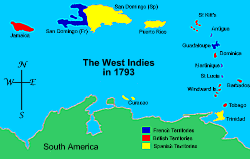 |
 |
 |
San Domingo's Bloody Revolt
The island of San Domingo (now Haiti) was one of the richest imperial possessions in the world and the struggle between France and the local blacks for control of its wealth resulted in savage warfare that bordered on genocide. San Domingo was initially shared between France and Spain, with the Spanish occupying the eastern portion, but in 1795 that territory - together with Louisiana - was ceded to France as part of the Treaty of Ildefonso. White troops were stationed on San Domingo but were ravaged by yellow fever and so to boost its defensive capablities, France recruited and trained black soldiers. Initially a satisfactory outcome - black troops helped throw out a British force in 1798 - the French later found they had created an independent-thinking monster. Despite its seemingly unified front against foreign powers, San Domingo had been racked by a brutal civil war since 1791 that saw regular bloodlettings between the blacks, coloureds and whites. From out of the turmoil rose General Pierre Toussaint-L'Ouverture, a black leader who was urbane, skilful and a fine military tactician, who used his political and martial skills to end the bloodshed and by 1800 had restored a semblance of peace to the island. When the Spanish finally pulled out of their eastern province, Toussaint decided to occupy it before troops sent from France could do so. It took him less than a month to be in complete control of the island. Still professing loyalty to France, Toussaint made a series of decisions - including declaring himself life-long governor of San Domingo - that were tantamount to announcing independence from France. An infuriated Napoleon Bonaparte sent an expeditionary force of some 35,000 men, the first of some 60,000, to restore the island to French control and placed his brother-in-law General Charles Leclerc in command. The arrival of the French in 1802 saw the rebels burn down several major towns and massacre all white inhabitants. The brutality set the tone for what would become a bloody war as each side carried out reprisals with extreme savagery. The French would get to a sacked town, find hundreds of countrymen killed and mutilated, and would then set about exacting revenge upon local black inhabitants. The deaths of hundreds of people at a time was common. Initially, the French advance progressed well but soon the tide turned as Toussaint's men, fighting successfully as guerrillas, pushed the French out of key areas. Leclerc decided to break the will of resistance by promising that slavery would not be reintroduced to the island if the fighting ended and that all who laid down their arms would be allowed to join the French army. They were both lies, agreed to by Bonaparte, but they worked. |
|
|
Napoleon
Bonaparte
|
|
| Career | Portraits |
| Quotes | Family |
| Loves | Letters |
| Plots | Murdered? |
| His will | Places |
|
Era
of Napoleon
|
|
| Powers | Opponents |
| Coalitions | Allies |
| People | Timelines |
| Key sites | Shrapnel |
|
Warfare
|
|
| Campaigns | Battles |
| Armies | Generals |
| Marshals | Winners |
| Glossary | Medical |
| Weapons | 1812 War |
| Uniforms | Battlefields |
|
War
at Sea
|
|
| Naval War | Heroes |
| Artworks | Signals |
| Nelson | Trafalgar |
|
Maps
|
|
| Key Maps | Peninsula |
| Animated | 1796/1800 |
| 1809 | Russia |
|
French
Revolution
|
|
| Revolution | Guillotine |
| Posters | People |
|
Art,
Film, Games
|
|
| Education | Goya |
| Sharpe | Hornblower |
| Books | Movies |
| DVDs | Music |
| Wargames | Images |
| Cartoons | Caricatures |
|
Other
|
|
| About Us | Sources |
| Awards | Sitemap |
| Links | Militaria |
| Miniatures | Reenactors |
| Forum | Quizzes |
| Home | Waterloo Diorama |
